Design of a 2.4 & 5.8 GHz Efficient Circularly Polarized Rectenna for Wireless Power Transfer Applications
Abstract
:1. Introduction
2. Receiving Antenna Structure and Parameters
2.1. Antenna Radiation Principle
2.2. Antenna Parameter Scanning Analysis
2.3. Directional Pattern Analysis of Dual-Frequency Circularly Polarized Microstrip Slot Antenna
3. Design of Rectifier Circuit
3.1. Design of Output Low-Pass Filter
3.2. Design of Matching Circuit
- The RF energy of the working frequency of the rectifier circuit, that is, the base wave energy, passes through, prevents the second and higher harmonics generated by the diode from passing through, and reflects the harmonics back to the diode.
- Impedance matching between the receiving antenna and the rectifier diode is achieved, which prevents the energy received by the diode from entering the rectifier diode completely for rectification, which results in incomplete RF energy rectification and reduced rectification efficiency of the rectifier circuit.
- Prevents some irrelevant RF energy from entering the diode of the receiving antenna, thereby affecting the rectification efficiency of the main rectifier band.
3.3. Analysis of Simulation Results of Rectifier Circuit
4. Experimental Results
5. Conclusions
Author Contributions
Funding
Data Availability Statement
Acknowledgments
Conflicts of Interest
References
- Roselli, L.; Carvalho, N.B.; Alimenti, F.; Mezzanotte, P.; Orecchini, G.; Virili, M.; Mariotti, C.; Goncalves, R.; Pinho, P. Smart surfaces: Large area electronics systems for Internet of Things enabled by energy harvesting. Proc. IEEE 2014, 102, 1723–1746. [Google Scholar] [CrossRef]
- Boaventura, A.J.S.; Carvalho, N.B. A batteryless RFID remote control system. IEEE Trans. Microw. Theory Tech. 2013, 61, 2727–2736. [Google Scholar] [CrossRef]
- Zhao, J.; Subramanyam, G.; Yue, H. A dual-band rectifying antenna design for RF energy harvesting. In Proceedings of the 2020 IEEE 63rd International Midwest Symposium on Circuits and Systems (MWSCAS), Springfield, MA, USA, 9–12 August 2020; pp. 415–418. [Google Scholar] [CrossRef]
- Soumaya, A.; Mounir, R.; Terchoune, H.; Zbitou, J. High Efficiency Rectifier Circuit for Ambient RF Energy Harvesting Applications at 5.8 Hz. In Proceedings of the 2019 IEEE 7th Mediterranean Congress of Telecommunications (CMT), Fez, Morocco, 24–25 October 2019; pp. 1–5. [Google Scholar] [CrossRef]
- An, C.; Ryu, H.G. Efficient microwave power transfer system using retrodirective antenna array. Int. J. Electron. 2023, 110, 391–403. [Google Scholar] [CrossRef]
- Lin, W.; Ziolkowski, R.W. High performance electrically small Huygens rectennas enable wirelessly powered Internet of Things sensing applications: A review. Engineering 2022, 11, 42–59. [Google Scholar] [CrossRef]
- Dang, K.; Liu, H.; Zhang, C.; Huo, S.; Zhan, P.; Qiu, Z.; Zhang, Y.; Zhou, H.; Ning, J.; Zhang, J.; et al. First Demonstration of Watt-Level C-Band MMIC Rectifier With GaN Schottky Diode. IEEE Microw. Wirel. Technol. Lett. 2023, 33, 591–594. [Google Scholar] [CrossRef]
- Sun, H. An Enhanced Rectenna Using Differentially-Fed Rectifier for Wireless Power Transmission. IEEE Antennas Wirel. Propag. Lett. 2016, 15, 32–35. [Google Scholar] [CrossRef]
- Song, C.; Huang, Y.; Zhou, J.; Carter, P.; Yuan, S.; Xu, Q.; Fei, Z. Matching Network Elimination in Broadband Rectennas for High-Efficiency Wireless Power Transfer and Energy Harvesting. IEEE Trans. Ind. Electron. 2017, 64, 3950–3961. [Google Scholar] [CrossRef] [Green Version]
- Nie, M.J.; Yang, X.X.; Tan, G.N.; Han, B. A Compact 2.45-GHz Broadband Rectenna Using Grounded Coplanar Waveguide. IEEE Antennas Wirel. Propag. Lett. 2015, 14, 986–989. [Google Scholar] [CrossRef]
- Chandravanshi, S.; Sarma, S.S.; Akhtar, M.J. Design of Triple Band Differential Rectenna for RF Energy Harvesting. IEEE Trans. Antennas Propag. 2018, 66, 2716–2726. [Google Scholar] [CrossRef]
- Mavaddat, A.; Armaki, S.H.M.; Erfanian, A.R. Millimeter-Wave Energy Harvesting Using 4*4 Microstrip Patch Antenna Array. IEEE Antennas Wirel. Propag. Lett. 2014, 14, 515–518. [Google Scholar] [CrossRef]
- Sakai, N.; Noguchi, K.; Itoh, K. A 5.8-GHz band highly efficient 1-W rectenna with short-stub-connected high-impedance dipole antenna. IEEE Trans. Microw. Theory Tech. 2021, 69, 3558–3566. [Google Scholar] [CrossRef]
- Niotaki, K.; Kim, S.; Jeong, S.; Collado, A.; Georgiadis, A.; Tentzeris, M.M. A compact dual-band rectenna using slot-loaded dual band folded dipole antenna. IEEE Antennas Wirel. Propag. Lett. 2013, 12, 1634–1637. [Google Scholar] [CrossRef]
- Borchardt, J.J.; Lapointe, T.C. U-slot patch antenna principle and design methodology using characteristic mode analysis and coupled mode theory. IEEE Access 2019, 7, 109375–109385. [Google Scholar] [CrossRef]
- Ren, Y.J.; Chang, K. 5.8-GHz circularly polarized dual-diode rectenna and rectenna array for microwave power transmission. IEEE Trans. Microw. Theory Tech. 2006, 54, 1495–1502. [Google Scholar] [CrossRef]
- Mansour, M.M.; Kanaya, H. Novel L-slot matching circuit integrated with circularly polarized rectenna for wireless energy harvesting. Electronics 2019, 8, 651. [Google Scholar] [CrossRef] [Green Version]
- Li, Y.; Lu, Z.; Yang, L. CPW-fed slot antenna for medical wearable applications. IEEE Access 2019, 7, 42107–42112. [Google Scholar] [CrossRef]
- Divarathne, C.; Karmakar, N. A maximum likelihood based tag detection technique for MIMO chipless RFID systems. In Proceedings of the 2014 IEEE International Microwave and RF Conference (IMaRC), Bangalore, India, 15–17 December 2014; pp. 5–8. [Google Scholar] [CrossRef]
- Zhang, Q.; Ou, J.H.; Wu, Z.; Tan, H.Z. Novel microwave rectifier optimizing method and its application in rectenna designs. IEEE Access 2018, 6, 53557–53565. [Google Scholar] [CrossRef]
- Chen, Y.Y.; Jiao, Y.C.; Zhao, G.; Zhang, F.; Liao, Z.L.; Tian, Y. Dual-band dual-sense circularly polarized slot antenna with a C-shaped grounded strip. IEEE Antennas Wirel. Propag. Lett. 2011, 10, 915–918. [Google Scholar] [CrossRef]
- Shariati, N.; Rowe, W.S.; Scott, J.R.; Ghorbani, K. Multi-service highly sensitive rectifier for enhanced RF energy scavenging. Sci. Rep. 2015, 5, 9655. [Google Scholar] [CrossRef] [Green Version]
- Rajawat, A.; Suri, K.; Mohta, M. Design of an efficient rectifier circuit based on karthaus-fischer voltage multiplier for energy harvesting. In Intelligent Communication, Control and Devices: Proceedings of ICICCD 2017; Springer: Berlin/Heidelberg, Germany, 2018; pp. 913–922. [Google Scholar] [CrossRef]
- Yue, X.; Du, S. A 2-Mode Reconfigurable SSHI Rectifier with 3.2 X Lower Cold-Start Requirement for Piezoelectric Energy Harvesting. In Proceedings of the 2022 29th IEEE International Conference on Electronics, Circuits and Systems (ICECS), Glasgow, UK, 24–26 October 2022; pp. 1–4. [Google Scholar] [CrossRef]
- Saito, K.; Nishiyama, E.; Toyoda, I. A 2.45-and 5.8-GHz dual-band stacked differential rectenna with high conversion efficiency in low power density environment. IEEE Open J. Antennas Propag. 2022, 3, 627–636. [Google Scholar] [CrossRef]
- Bhatt, K.; Kumar, S.; Kumar, P.; Tripathi, C.C. Highly efficient 2.4 and 5.8 GHz dual-band rectenna for energy harvesting applications. IEEE Antennas Wirel. Propag. Lett. 2019, 18, 2637–2641. [Google Scholar] [CrossRef]
- Huang, J.K.; Chen, S.Y. A compact slot loop rectenna for dual-band operation at 2.4-and 5.8-GHz bands. In Proceedings of the 2016 IEEE International Symposium on Antennas and Propagation (APSURSI), Fajardo, PR, USA, 26 June–1 July 2016; pp. 411–412. [Google Scholar] [CrossRef]

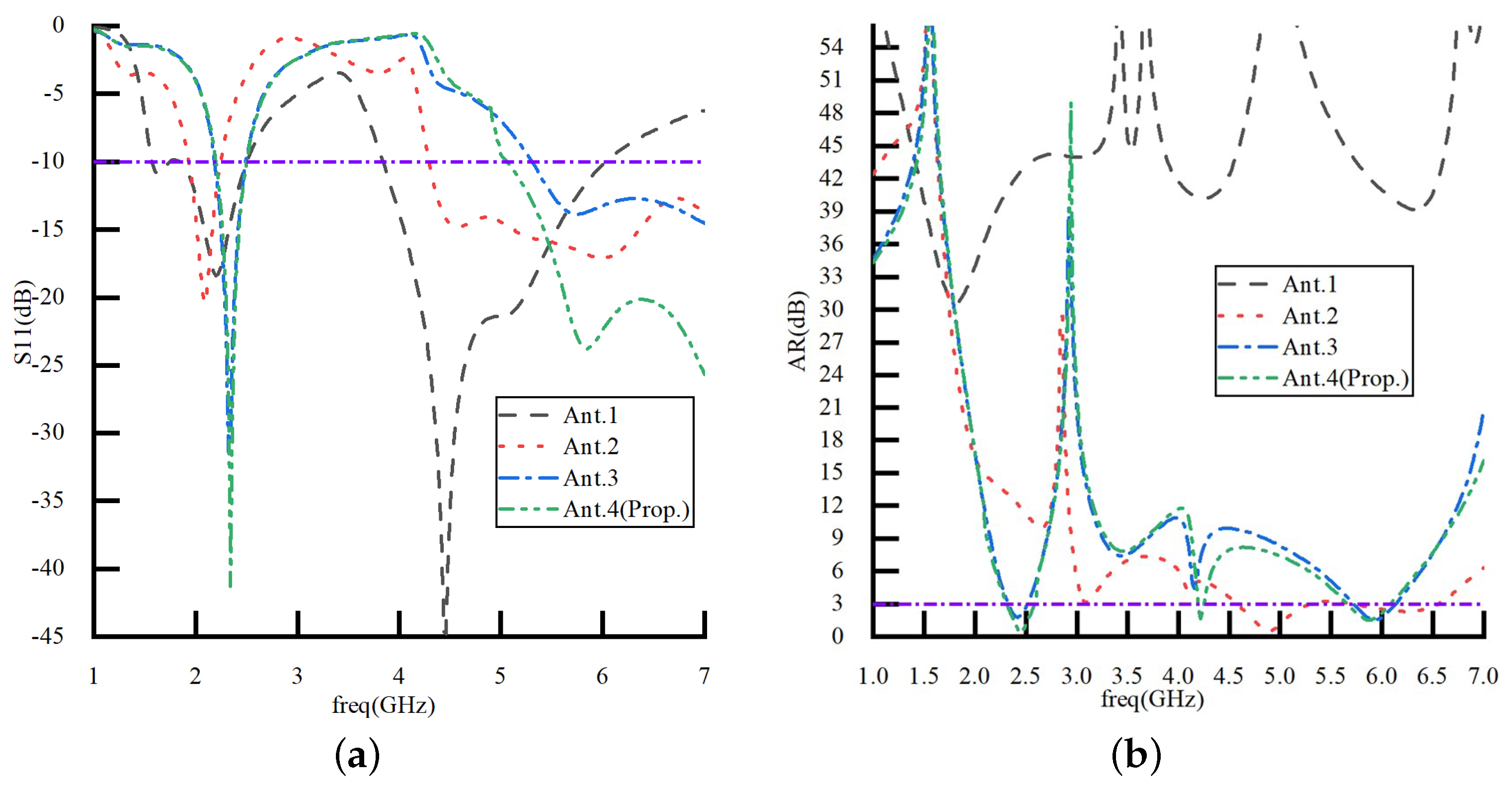
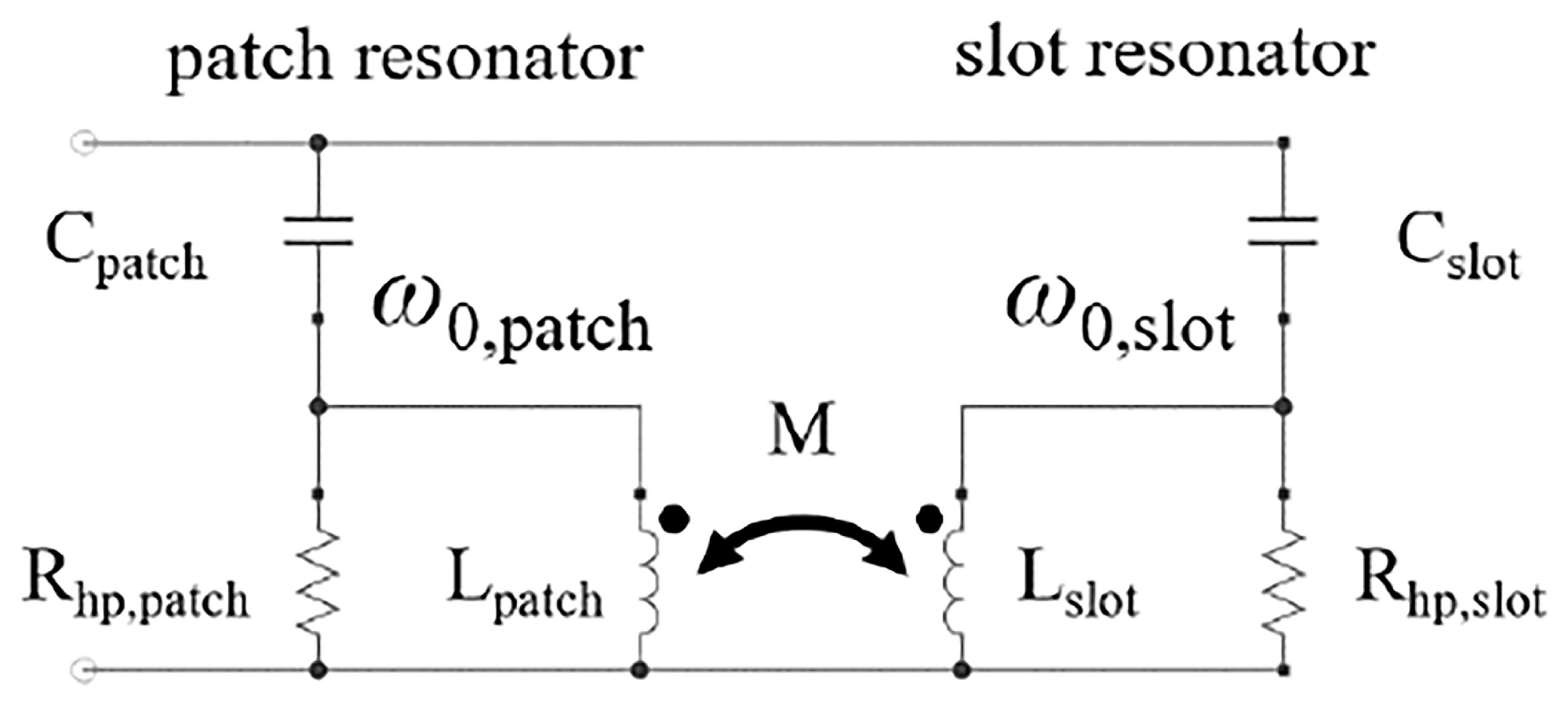

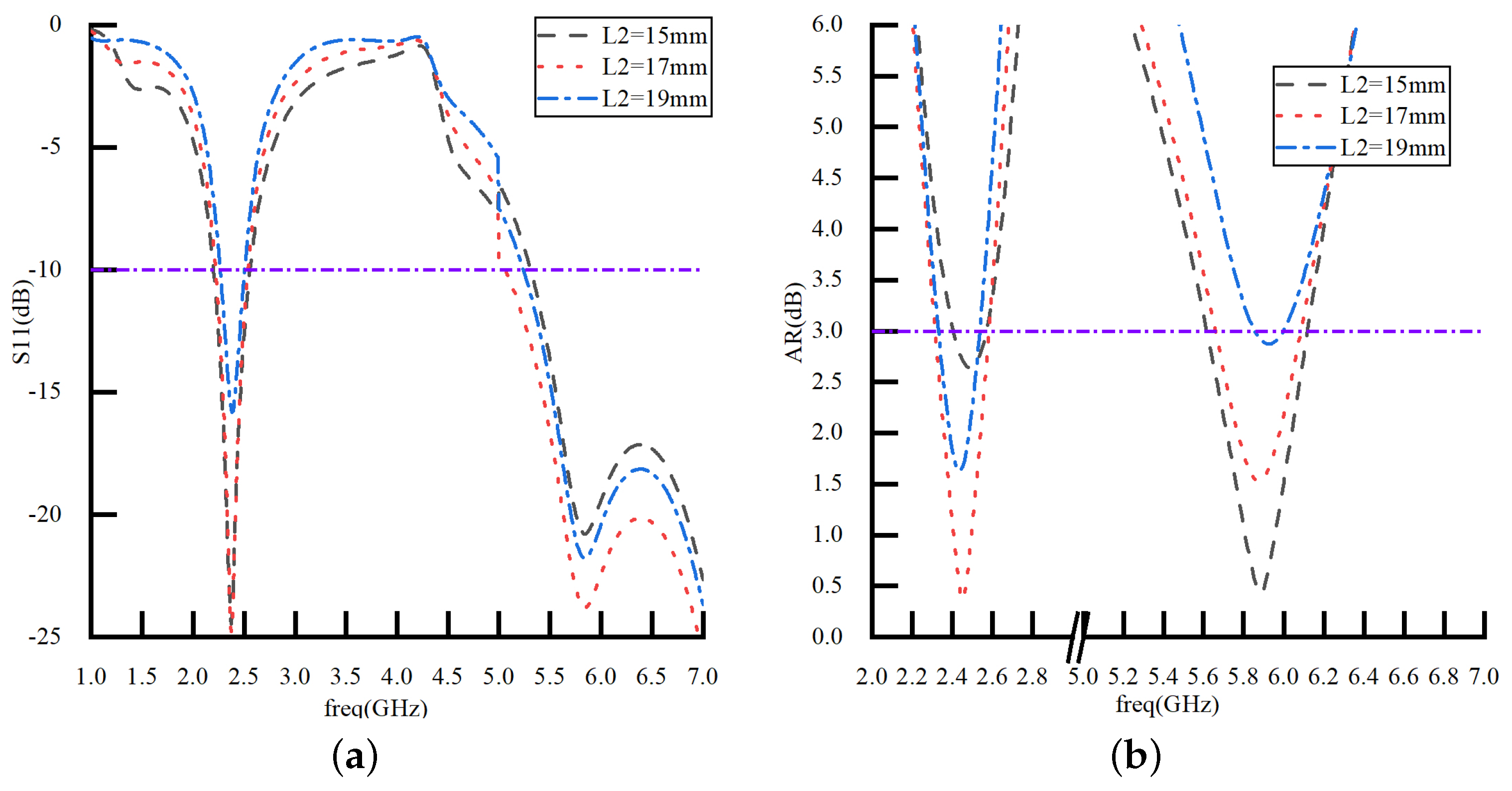

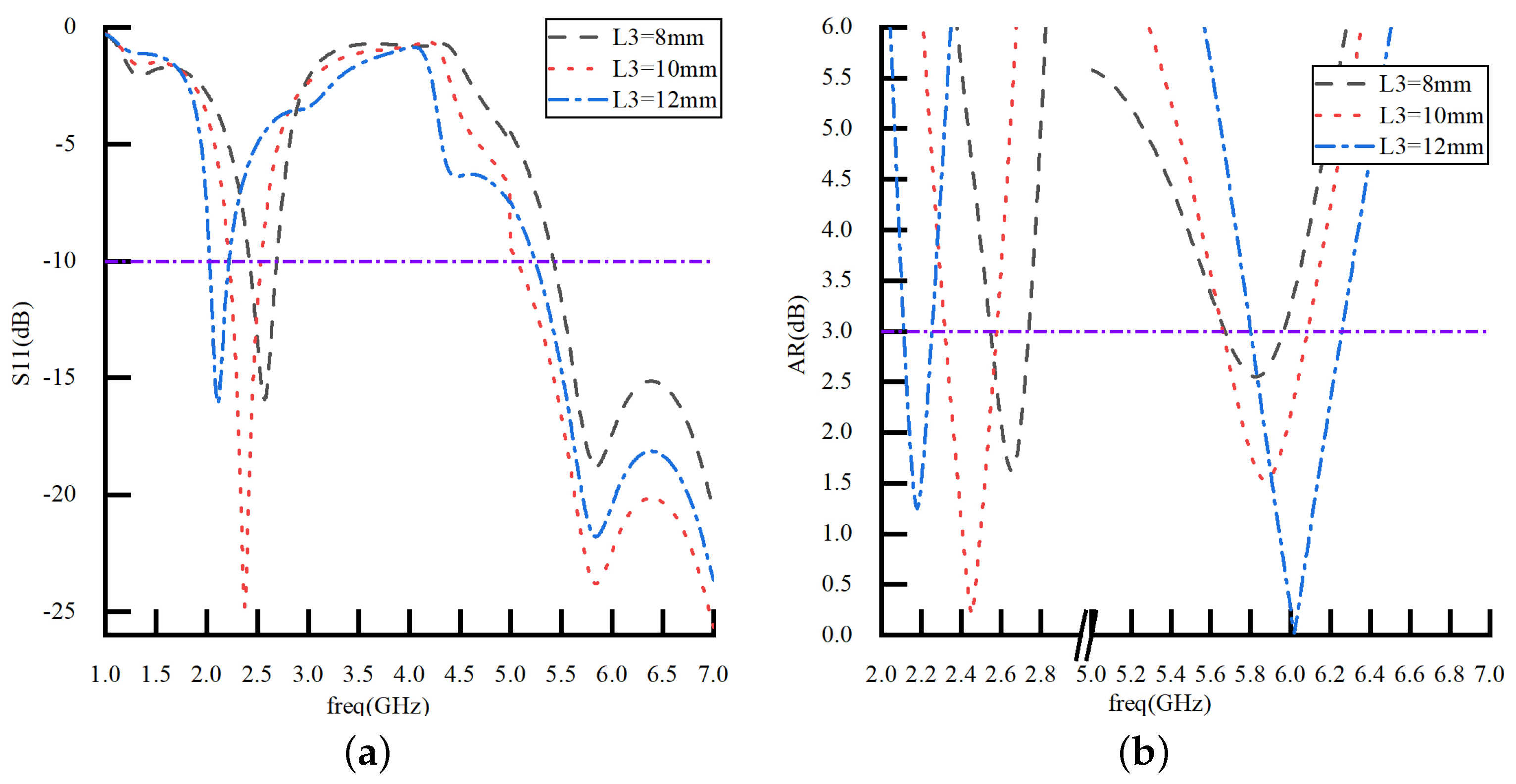
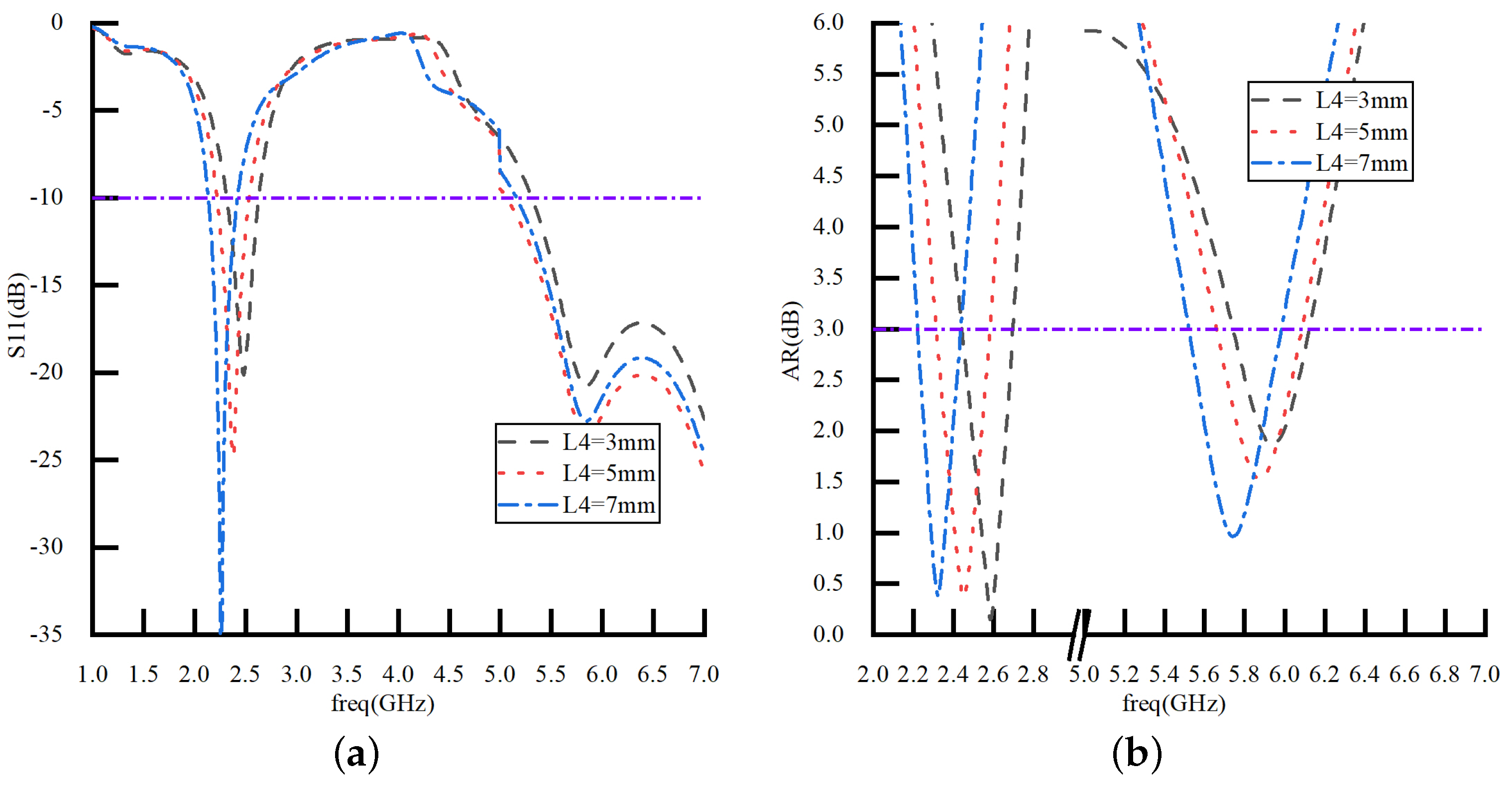
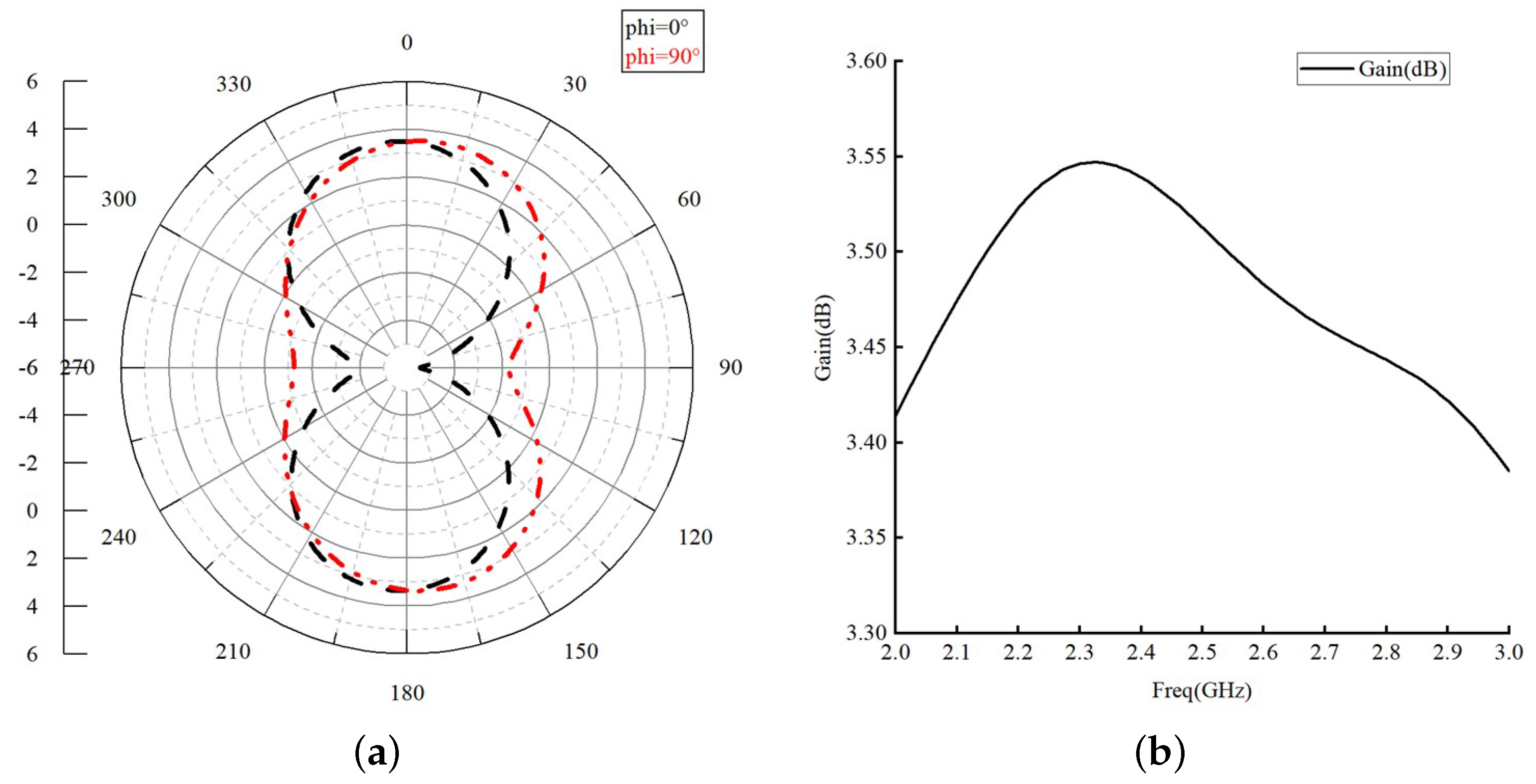
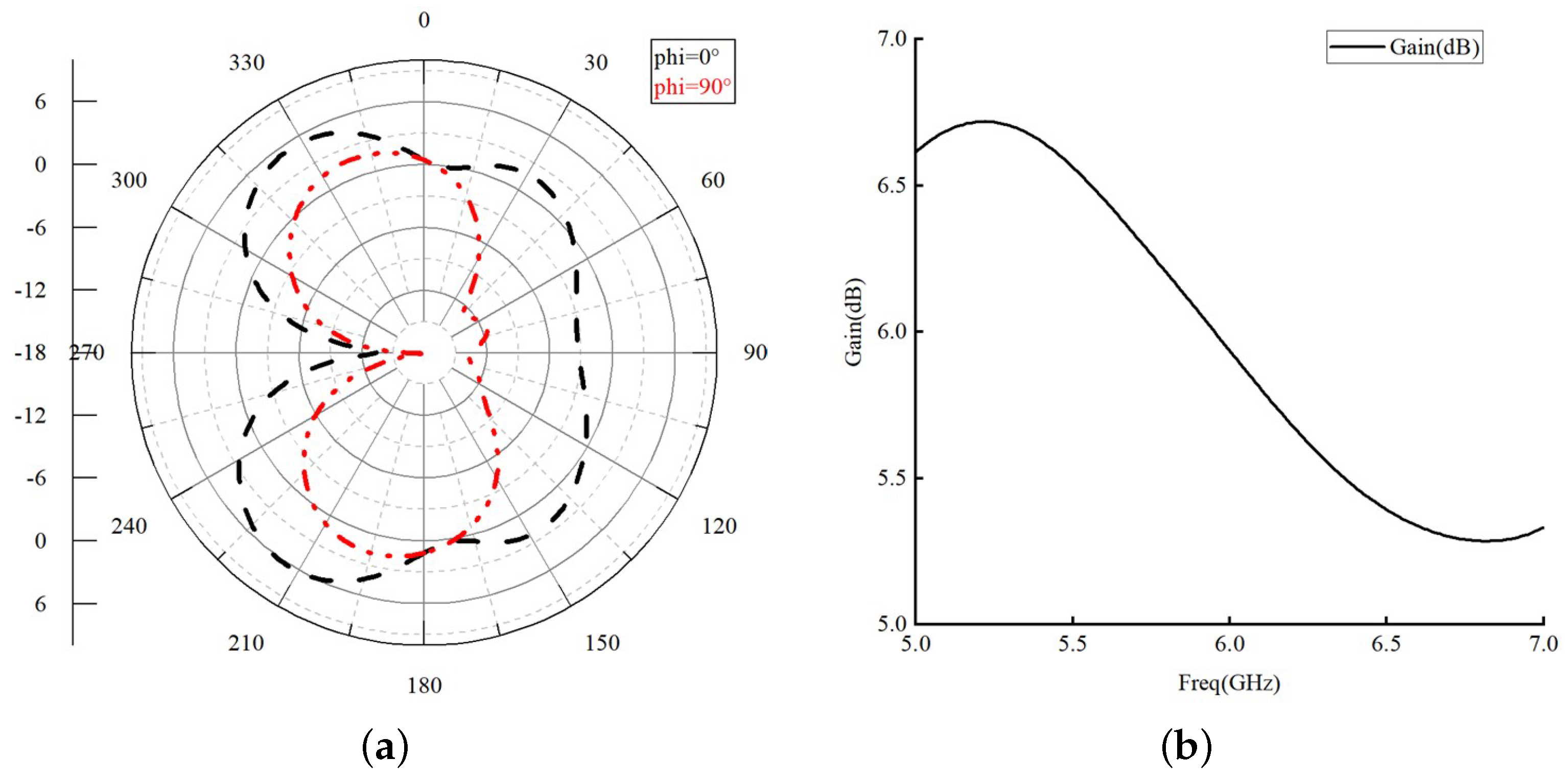

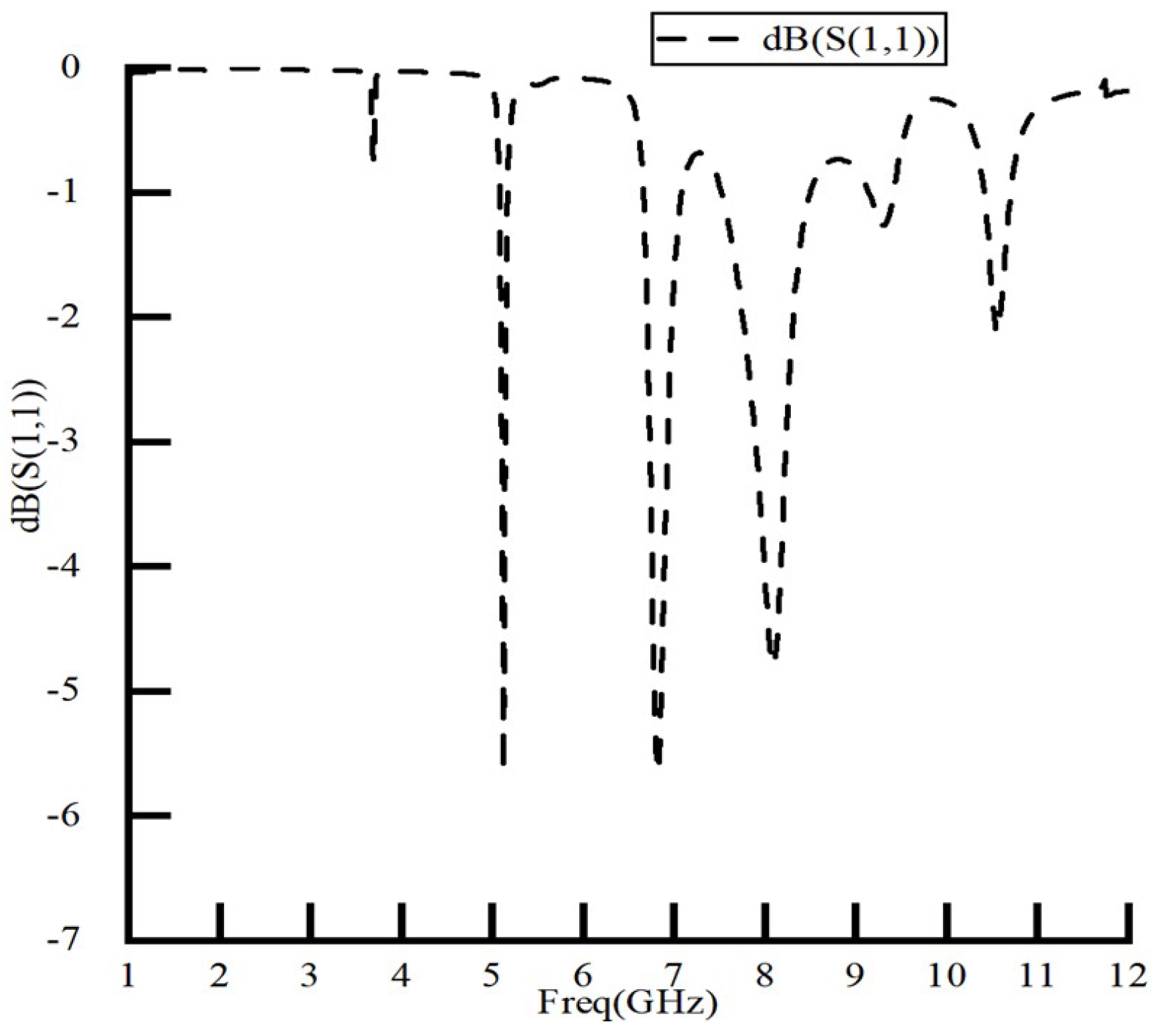

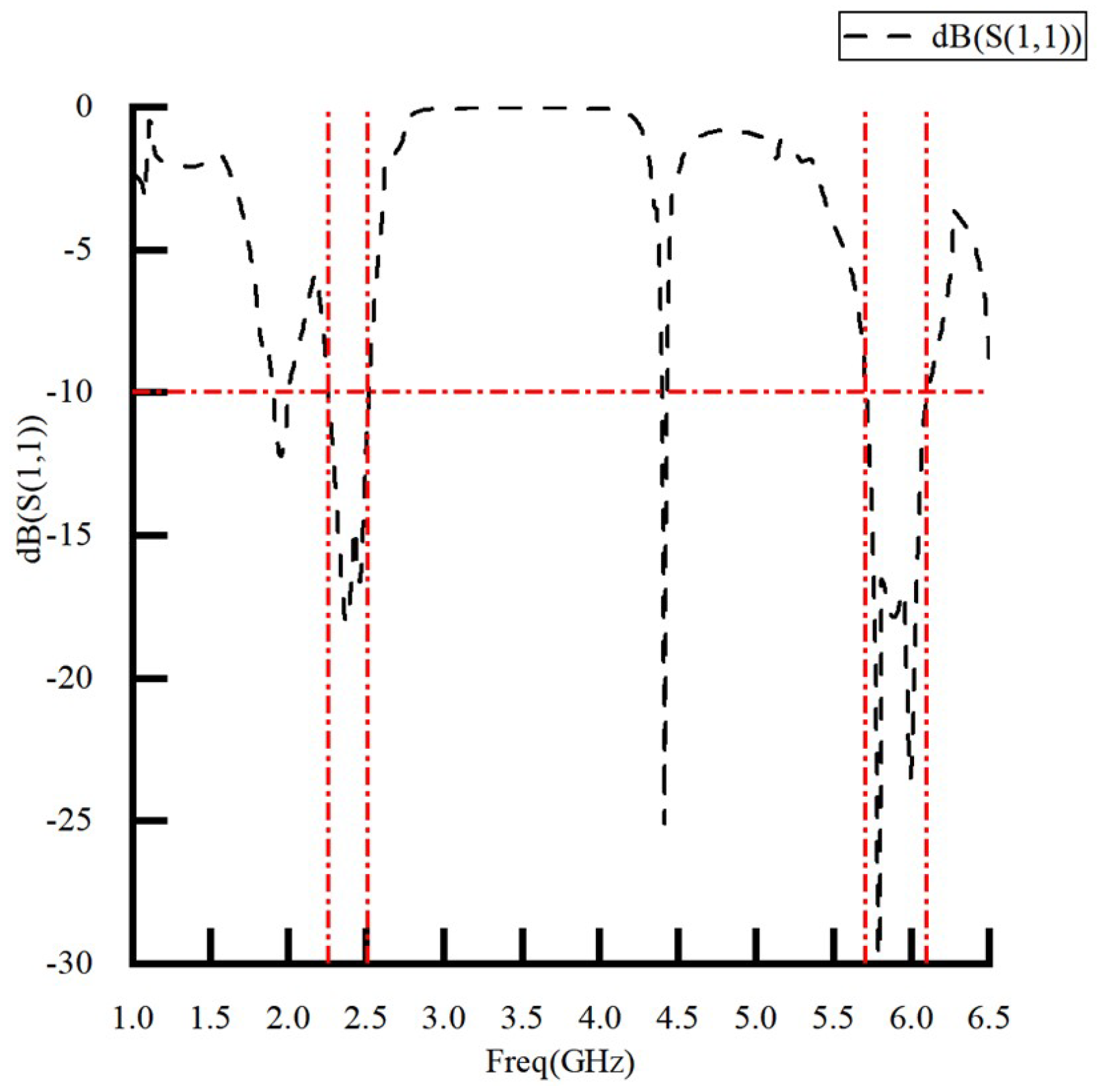
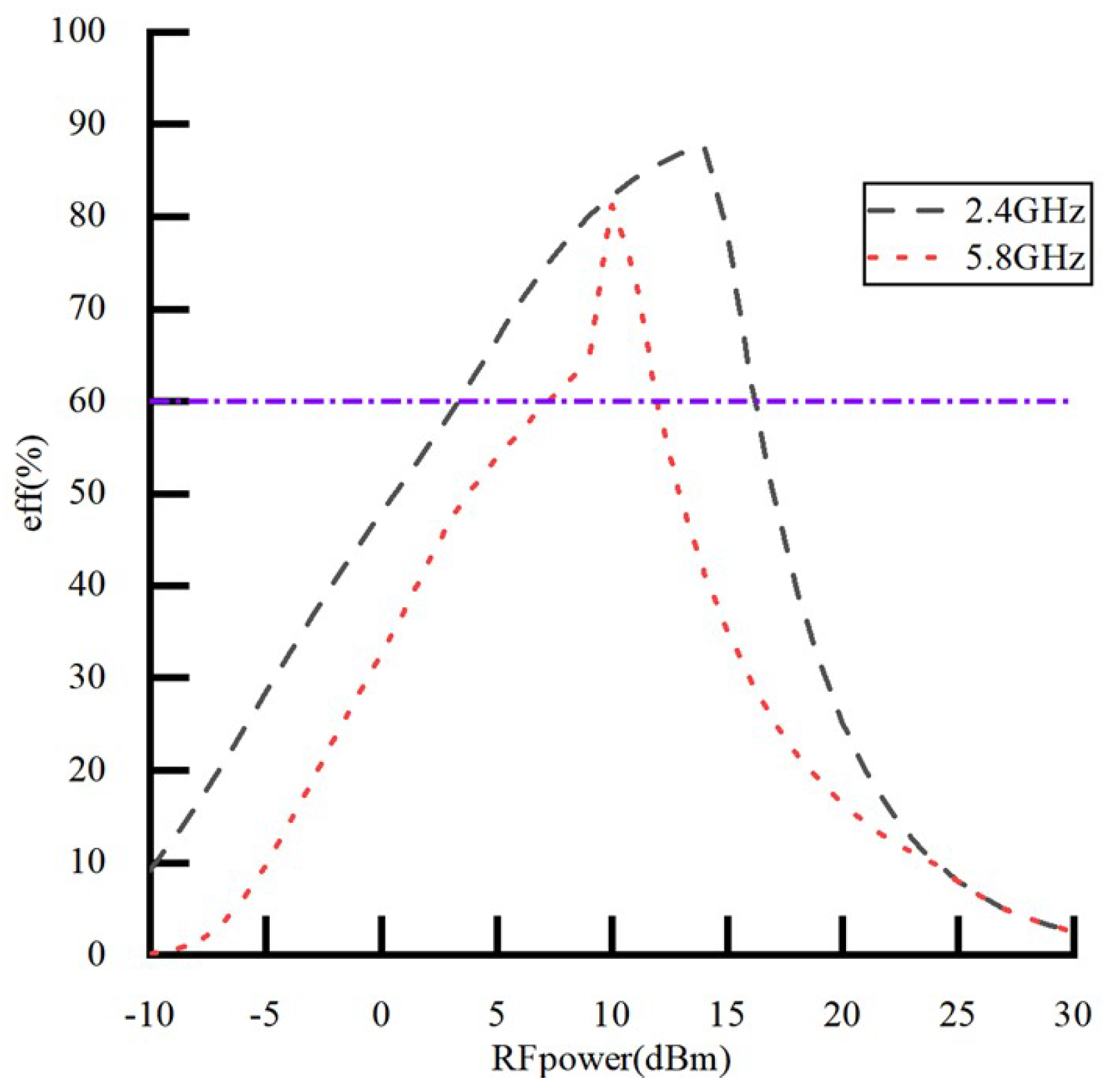

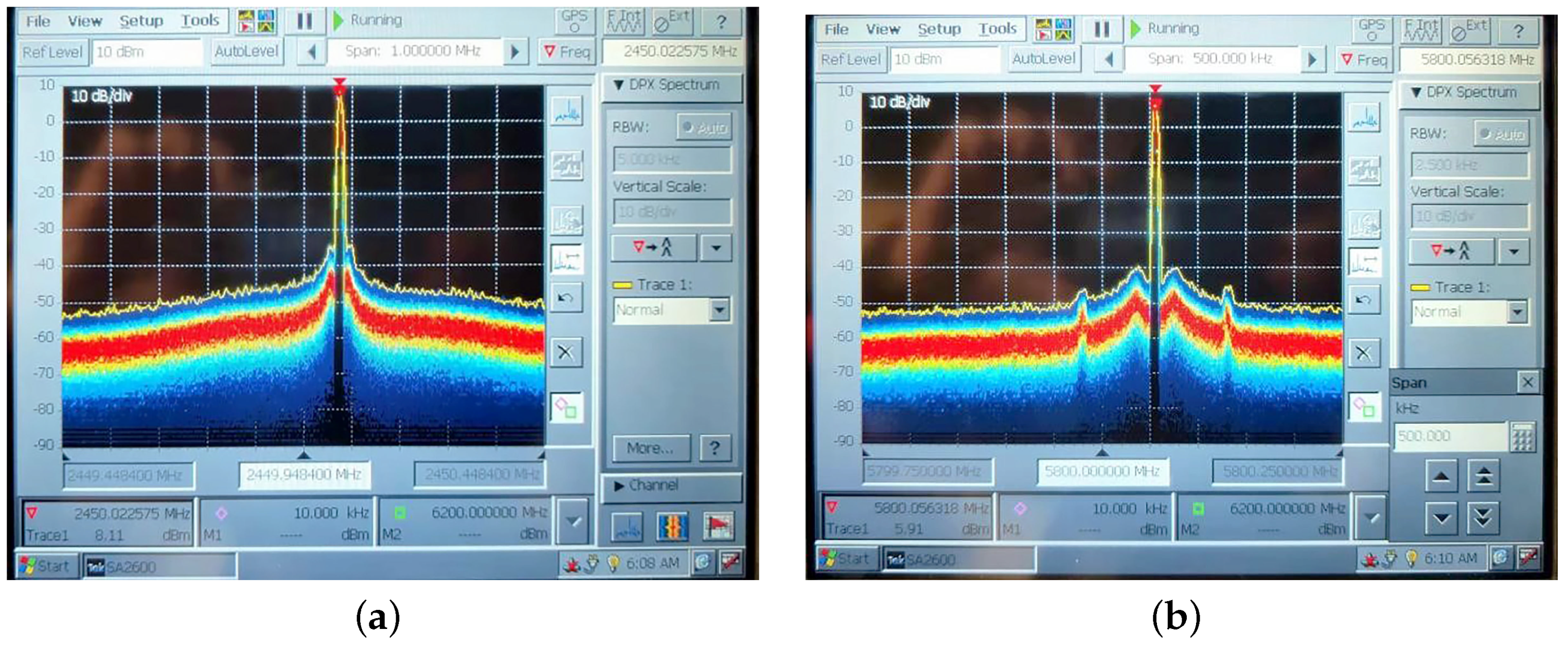


| Parameters | SX | SY | d0 | L4 | W | L1 | D |
| Unit(mm) | 45 | 45 | 5 | 5 | 10 | 13 | 6 |
| Parameters | d1 | d2 | L | W2 | L2 | L3 | W3 |
| Unit(mm) | 3 | 4 | 13 | 30 | 17 | 10 | 3 |
| Input Frequency | Simulation DC(V)/Efficiency | Measurement DC(V)/Efficiency |
|---|---|---|
| 2.4 | 3.85/82.3% | 3.71/79.3% |
| 5.8 | 3.83/82% | 2.82/60.0% |
Disclaimer/Publisher’s Note: The statements, opinions and data contained in all publications are solely those of the individual author(s) and contributor(s) and not of MDPI and/or the editor(s). MDPI and/or the editor(s) disclaim responsibility for any injury to people or property resulting from any ideas, methods, instructions or products referred to in the content. |
© 2023 by the authors. Licensee MDPI, Basel, Switzerland. This article is an open access article distributed under the terms and conditions of the Creative Commons Attribution (CC BY) license (https://creativecommons.org/licenses/by/4.0/).
Share and Cite
Deng, X.; Yang, P.; Chen, S.; Ren, W. Design of a 2.4 & 5.8 GHz Efficient Circularly Polarized Rectenna for Wireless Power Transfer Applications. Electronics 2023, 12, 2645. https://doi.org/10.3390/electronics12122645
Deng X, Yang P, Chen S, Ren W. Design of a 2.4 & 5.8 GHz Efficient Circularly Polarized Rectenna for Wireless Power Transfer Applications. Electronics. 2023; 12(12):2645. https://doi.org/10.3390/electronics12122645
Chicago/Turabian StyleDeng, Xizhou, Ping Yang, Shengtao Chen, and Wang Ren. 2023. "Design of a 2.4 & 5.8 GHz Efficient Circularly Polarized Rectenna for Wireless Power Transfer Applications" Electronics 12, no. 12: 2645. https://doi.org/10.3390/electronics12122645





